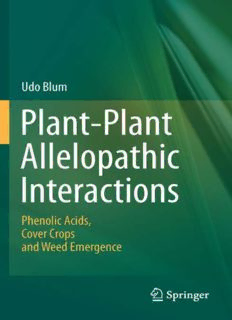
Plant-Plant Allelopathic Interactions: Phenolic Acids, Cover Crops and Weed Emergence PDF
Preview Plant-Plant Allelopathic Interactions: Phenolic Acids, Cover Crops and Weed Emergence
Plant–Plant Allelopathic Interactions Udo Blum Plant–Plant Allelopathic Interactions Phenolic Acids, Cover Crops and Weed Emergence 123 UdoBlum DepartmentofPlantBiology NorthCarolinaStateUniversity Raleigh, NC27695-7612 USA [email protected] ISBN978-94-007-0682-8 e-ISBN978-94-007-0683-5 DOI10.1007/978-94-007-0683-5 SpringerDordrechtHeidelbergLondonNewYork LibraryofCongressControlNumber:2011922311 ©SpringerScience+BusinessMediaB.V.2011 Nopartofthisworkmaybereproduced,storedinaretrievalsystem,ortransmittedinanyformorby anymeans,electronic,mechanical,photocopying,microfilming,recordingorotherwise,withoutwritten permissionfromthePublisher,withtheexceptionofanymaterialsuppliedspecificallyforthepurpose ofbeingenteredandexecutedonacomputersystem,forexclusiveusebythepurchaserofthework. Printedonacid-freepaper SpringerispartofSpringerScience+BusinessMedia(www.springer.com) Thisbookisdedicatedtoallwhohave laboredandwilllaborinthefieldof plant–plant allelopathic interactions. Preface For part of my PhD thesis I characterized the distribution of tannic acids in soils underneath sumac (Rhus copallina L.) located in abandoned fields of central Oklahoma(BlumandRice1969).Largequantitiesoftannicacidswerefoundinthe litter and organic residues underneath sumac. Tannic acids, which are very water soluble, were also found in the soil to a depth of 75 cm, with a definite zone of concentrationat45–55cm.Thetechniquesutilizedatthetimetorecoverandquan- tifytannicacidswererudimentary,atbest.Amountsbelow400ppmaddedtosoils couldnotberecovered,eventhoughconcentrationsaslowas33ppmaddedtosoils inhibited nodulation of red kidney beans (Phaseolus vulgaris L. “Burpee”). These observationsandtheirimplicationstoplant–plantallelopathicinteractionsintrigued meatthetimeandImadeapromisetomyselfthatIwouldtakeanotherlookatthis subjectinthefuture.Around1980Iwasreadytofulfillthatpromise.Forthenext 20 plus years research in my laboratory was primarily focused on various aspects ofplant–plantallelopathicinteractionswithanemphasisonseedlingbehavior,soil chemistry,andmicrobiology.Thisbookisasummaryandretrospectiveanalysisof thisresearchprogram. Although research publications on allelopathy have increased at a phenomenal ratesincethe1980s,whatisgenerallylackingarein-depthanalysesandintegration ofthisliterature.Forexample,aquicksearchofScienceCitationIndexyielded112 publicationsbetween1981and1990,627publicationsbetween1991and2000,and 1,615 publications between 2001 and 2010. The terms “allelopathic interactions” yielded 6, 58, and 212 publications over the same time intervals. However, less than10%ofthese276citationslistedforallelopathicinteractionscouldbeclassi- fied as review papers for allelopathic interactions of higher plants. These reviews, with minor exceptions, summarized, described, pooled, and/or integrated data for plant–plantallelopathicinteractionsdeterminedfordifferentspecies,environments, and ecosystems utilizing a range of different methods/protocols. Such reviews are useful in that they can identify potential/likely mechanisms that may bring about plant–plant allelopathic interactions and provide general guidelines and directions forfutureresearch.However,toidentifyanddetermineactualmechanismsthatcon- trol and/or regulate the expression of plant–plant allelopathic interactions within a given ecosystem requires in-depth quantitative analyses of individual ecosystem vii viii Preface processes and their interactions utilizing consistent experimental protocols. The research described in this book is an attempt to do just that for one type of ecosystem. This book does not provide a comprehensive review of the plant–plant allelo- pathic interaction literature. For a general review of this literature the reader may wishtoreadseveralofthefollowing:Rice(1974,1979,1983,1984,1995),Putnam andTang(1986),Waller(1987),Siqueriaetal.(1991),Inderjitetal.(1995,1999), InderjitandKeating(1999),Macíasetal.(1999,2004),Reigosaetal.(2006),Fujii andHiradate(2007),Willis(2007),andZengetal.(2008). Thereareseveralthingsthatareuniqueaboutthisbook: a. Thegeneralformatisthatofresearchpaperspublishedinscientificjournals.The materialsareorganizedinsectionssuchas,Abstract,Introduction,Materialsand Methods,andResultsandDiscussion. b. There are four chapters, including an introduction to allelopathic plant–plant interactions (Chapter 1). They all emphasize basic aspects of science, but Chapter2ismoretheoretical/hypotheticalinnature,Chapter3ismorepractical innature,andChapter4integratestheinformationpresentedinChapters2and3 andsuggestsfuturedirectionforresearchinplant–plantallelopathicinteractions. c. Comments regarding logic, reasons, and justifications, for various procedures usedareprovidedthroughoutthebook. d. TheScientificMethodanditsapproachtoresearchareemphasized.Forexample, insteadofdefinitiveconclusionsattheendofthebookconsandprosareprovided so that readers can draw their own conclusions. The reader will also find an extendedlistingofif-thenhypotheses,and e. Althoughabroadrangeofliteratureisincluded,theprimaryfocusofthisbook is a summary and retrospective analysis of some 20 plus years of research on plant–plantallelopathicinteractionsatNorthCarolinaStateUniversity. The above format was chosen so that researchers, students, farmers, as well as layman interested in science, reduced tillage production, and plant–plant allelo- pathicinteractions,inparticular,canlearntoappreciateandunderstandthenature ofscience,itsbenefitsandlimitations,andourpresentknowledgeoftheactionof naturalproductssuchasphenolicacidsinsoilonplantgrowthanddevelopment. Raleigh,NC UdoBlum August19,2010 References BlumU,RiceEL(1969)Inhibitionofsymbioticnitrogen-fixationbygallicandtannicacidand possiblerolesinold-fieldsuccession.TorreyBotClub96:531–544 Fujii Y, Hiradate S (2007) Allelopathy: new concepts and methodology. Science Publishers, Enfield,NY Inderjit, Keating KI (1999) Allelopathy: principles, procedures, processes, and promises for biologicalcontrol.AdvAgro67:141–231 Preface ix Inderjit, Daskshini KMM, Einhellig FA (1995) Allelopathy: organisms, processes, and applica- tions.ACSsymposiumseries,vol582.AmericanChemicalSociety,Washington,DC Inderjit,DaskshiniKMM,FoyCL(1999)Principlesandpracticesinplantecology:allelochemical interactions.CRCPress,BocaRaton,FL MacíasFA,GalindoJGC,MolinilloJMG,CutlerH(1999)RecentadvancesinallelopathyI.A scienceforthefuture.CádizUniversityPress,PuertoRealCádiz,Spain MacíasFA,GalindoJGC,MolinilloJMG,CutlerH(2004)Allelopathy:chemistry&modesof actionofallelochemicals.CRCPress,BocaRaton,FL PutnamAR,TangCS(1986)Scienceofallelopathy.Wiley,NewYork,NY ReigosaMJ,PedrolN,GonzalezL(2006)Allelopathy.Aphysiologicalprocesswithecological implications.Springer,Dordrecht,TheNetherlands RiceEL(1974)Allelopathy.AcademicPress,Orlando,FL RiceEL(1979)Allelopathy–anupdate.BotRev45:15–109 RiceEL(1983)Pestcontrolwithnature’schemicals:allelochemicsandpheromonesingardening andagriculture.UniversityofOklahomaPress,Norman,NY RiceEL(1984)Allelopathy.AcademicPress,Orlando,FL RiceEL(1995)Biologicalcontrolofweedsandplantdiseases:advancesinappliedallelopathy. UniversityofOklahomaPress,Norman,NY SiqueiraJO,NairMG,HammerschmidtR,SafirGR(1991)Significanceofphenoliccompounds inplant-soil-microbialsystems.CritRevPlantSci10:63–121 WallerGR(1987)Allelochemicals:roleinagricultureandforestry.ACSsymposiumseries,vol 330.AmericanChemicalSociety,Washington,DC WillisRJ(2007)Thehistoryofallelopathy.Springer,Dordrecht,TheNetherlands ZengRS,MallikAU,LuoSM(2008)Allelopathyinsustainableagricultureandforestry.Springer, NewYork,NY
Description: